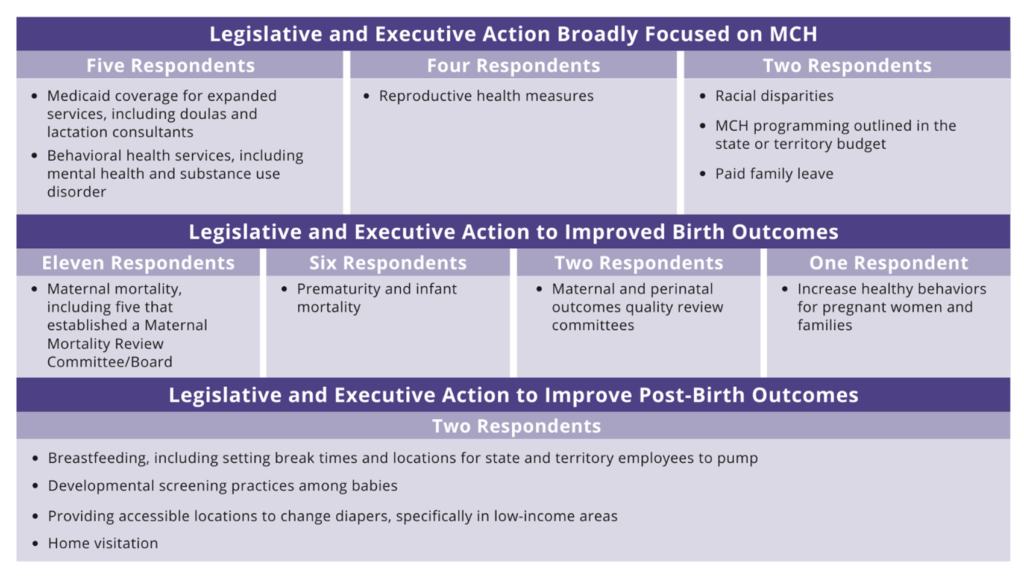The Maternal and Child Health Update includes findings from a survey of senior state and territory health officials regarding MCH policy topics. Questions are modified from year to year to address new and emerging issues, with the latest iteration focused on Governors’ MCH priorities, coverage and payment reforms, health equity, behavioral health, health workforce, and improving health outcomes. Multiple agencies from states and territories contributed to the survey, including MCH Directors, Medicaid Directors, and Governors’ offices. Because the survey was designed before the COVID-19 pandemic, NGA conducted a supplemental survey focused on COVID-19 related MCH considerations and released findings in August 2020.
Maternal and Child Health Through a Governor’s Lens
The National Governors Association Center for Best Practices’ (NGA Center) Maternal and Child Health Update (MCH Update) presents the results from a survey of senior state and territory health officials regarding MCH policy topics. Questions are modified from year to year to address new and emerging issues. The 2020 survey focused on Governors’ MCH priorities, coverage and payment reforms, health equity, behavioral health, health workforce, and improving health outcomes. Women from multiple agencies with states and territories contributed to the survey, including MCH Directors, Medicaid Directors, and Governors’ offices.
Forty-three states and territories participated in the survey, though response rates vary by question. Survey data were collected during the first half of 2020. Because the survey was designed before the COVID-19 pandemic, the NGA Center conducted a supplemental survey focused on COVID-19 related MCH considerations and released findings in August 2020.
Governors’ Priorities for Maternal and Child Health
To understand priority MCH issue areas for Governors, the NGA Center asked Governors’ staff to choose the top three priorities from a list of 13, with a write-in option. Figure 1 depicts the responses. Thirty-four respondents completed this question, with more than half (20 respondents) indicating that addressing maternal mortality is a priority. Sixteen respondents specify infant mortality, followed by eleven respondents each identifying decreasing substance use among pregnant women and improving birth outcomes as a priority.
Figure 1: Governors’ Maternal and Child Health Priorities

State & Territory Title V Priorities
Every five years, states and territories conduct a needs assessment to identify areas for opportunity in their MCH programs. The most recent needs assessment was completed in September 2020. Through the needs assessment process, states and territories identify seven to ten priority needs and develop a five-year state action plan describing how they will use the federal allocation from the Title V MCH Services Block Grant to States Program distributed by the Health Resources and Services Administration and the Maternal and Child Health Bureau with state match. Based on the priorities , states and territories identify evidence-based or -informed strategies that address their needs across six domains: women/maternal health; perinatal/infant health; child health; children with special health care needs; adolescent health; and cross-cutting and systems building. For purposes of this survey, the NGA Center focuses only on strategies under women/maternal health, perinatal/infant health, and cross-cutting/systems building domains, excluding those focused on children, adolescents, and children with special health care needs.
Due to the timing of the survey, many respondents provided a list of their Title V priorities for both the 2016 – 2020 and 2021 – 2025 periods. Table 1 includes a summary of the priorities. The most common theme identified (by 32 respondents) was providing quality, preventive care for infants, which includes practices such as early and continuous screenings and immunizations.
Table 1: State and Territory Title V Priorities – Summary of Common Themes

State & Territory Executive Action and Legislation to Address Maternal and Child Health
Twenty-five respondents indicated that there had been executive or legislative action related to MCH in 2019. Table 2 reflects measures highlighted by survey respondents, including actions focused on broad, systematic changes, birth outcomes, and those affecting the postpartum and infancy period. Eleven respondents had executive or legislative action focused on maternal mortality, including five that established or formalized a maternal mortality review committee or board through legislation or executive order. Six respondents indicated executive or legislative action addressing prematurity and infant mortality and five respondents provided information on executive or legislative action concerning Medicaid coverage and behavioral health services.

Additional Content Includes
Coverage and Payment
- Most Frequently Cited Medicaid/CHIP Payment or Delivery Reforms, by Type of Reform
Health Equity and Disparities
- Strategies to Address Racial Disparities in Maternal and Child Health
- Policy Initiatives to Address Socioeconomic Disparities Among Mothers and Children
Behavioral Health Care for Pregnant Women and New Mothers
Maternal and Child Health Workforce
- Health Professional Shortages Impacting Maternal and Child Health
Birth Outcomes and Early Childhood
- State and Territory Actions to Promote Healthy Birth Outcomes
- Groups Convened to Promote Healthy Birth Outcomes
- New or Innovative Breastfeeding Initiatives Planned in the Coming Year
- Infant and Early Childhood Strategies












